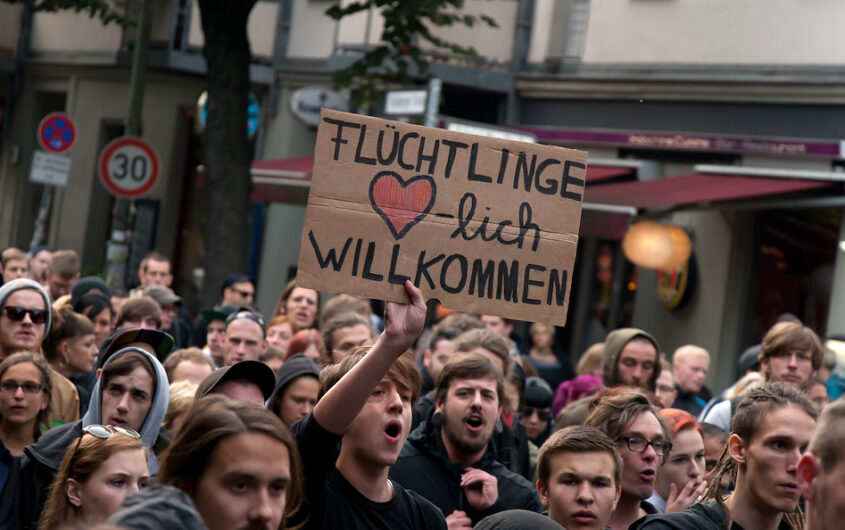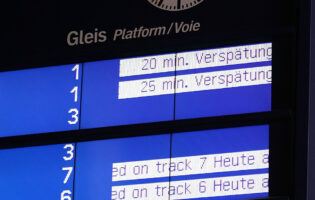
Montecruz Foto via Flickr
Refugees in Germany

Fiona Muhleisen
Halle Foundation/AGI Intern
Fiona Muhleisen is a research intern at AGI for the summer of 2023. She assists resident fellows with their research projects, manages databases, and helps organize and document events.
Ms. Muhleisen is currently pursuing a bachelor’s degree in International Relations at Pomona College with a minor in German Studies. She has completed coursework on topics including the intelligence community, U.S. foreign policy, German film, and German contemporary literature. Her research interests center on national security and the implications of democratic backsliding on transatlantic relationships.
Aside from her academic pursuits, Ms. Muhleisen is a research assistant for Pomona College’s German Department developing a course about Swiss film. In this capacity, she explores the European film industry and entertainment law. Ms. Muhleisen is fluent in German and Hungarian.
“We Can Do It” Again?
Eight years ago, in August 2015, former Chancellor Angela Merkel first used the phrase “Wir schaffen das” (we can do this) to signal Germany’s willingness to harbor the incoming refugees from Syria, Afghanistan and Iraq. What followed was an “impressive” effort, according to the Center for Global Development, to integrate nearly 1.8 million asylum seekers into German society and its labor market between 2014 and 2019.
Although initially unprepared for the challenge, Germany adapted its integration procedures for asylum seekers by facilitating labor market access and establishing early intervention programs focused primarily on language training and civic orientation. The main burden of providing housing and basic necessities fell on municipalities and counties, many of which were initially overwhelmed and lacked the infrastructure to accommodate their allocated share of refugees. These administrative divisions, however, were supported by civil society and ordinary citizens that embraced an opportunity to echo the sentiment of Chancellor Merkel’s statement regarding Willkommenskultur (welcoming culture).
A 2020 study by the Institute for Employment Research (IAB) found that around half of all refugees had become active participants in the labor market five years after their arrival. This was a slightly faster pace of integration than for previous refugee cohorts, helped by positive labor market conditions (i.e. a low unemployment rate and high levels of job security). A report by the European Trade Union Institute broadly concurred with the IAB’s conclusions although it found significant discrepancies along gender lines and demonstrated poor labor market access for refugees with limited permission to reside in-country.
The integration of the 2015 crisis’ refugees played out largely in line with the Federal Republic of Germany’s past migration experiences dating back to the “guest workers” of the 1950s. Subsequent arrivals from the 1980s until the early 2000s included several million ethnic Germans from the Soviet Union, as well as migration waves from Eastern and Southeastern Europe; all of these demographic groups also gained access to the German labor market. Indeed, Germany is considered the world’s second-most important migrant destination after the United States, with 26 percent of its population having some migration background (individuals who were either not born with German citizenship or who have at least one parent who was not born with German citizenship) as of 2021.
Chancellor Merkel was therefore right in predicting that Germany would be able to manage the influx, but it is also evident that the 2015 crisis contributed to significant changes in Germany’s political climate. The far-right Alternative for Deutschland (AfD) political party entered parliament for the first time in 2017 after switching their messaging from Euroskepticism to anti-immigration and xenophobia, gaining influence especially in areas where high unemployment, few migrant residents, and a dearth of younger generations led to the rejection of established political parties. This trend has been echoed by developments all over Europe, adding to political pressures to reduce migration rates and refugees flows into the EU.
Germany has arrived at a critical juncture. It has the capacity to manage yet another refugee crisis, provided local authorities receive additional help to accommodate migrants without compromising other services.
Russia’s invasion of Ukraine in 2022 has complicated this debate even further. On the one hand, most European countries welcomed Ukrainian refugees, many of whom are likely to eventually return home. Out of six million refugees, an estimated one million have fled to Germany where, as non-asylum seekers, most have received immediate work permits. Integration procedures introduced after 2015 have facilitated rapid access to culture-related courses, and accommodation is often provided by friends or family. The chances for successful integration are higher than for previous migrant cohorts, given Ukrainian refugees’ relatively high education levels and willingness to work, as demonstrated by the 18 percent employment rate of those surveyed from August to October 2022.
On the other hand, Europe has also been experiencing a renewed increase of migration levels from Africa and the Middle East; Germany alone is likely to receive half a million asylum requests in 2022 and 2023 combined. Compared to the 315,000 asylum applications received between 2020 and 2021, this is a marked increase after two pandemic years of disrupted international mobility. Facilities at the local level are increasingly stretched by the twin crises, but the federal government has not yet increased funding in a significant way. Calls by local politicians to reduce the intake of asylum seekers from other European countries, or even modifying the right to asylum in the constitution, have therefore increased.
The discussion has heated up after the AfD’s rise to second place in the polls this year, ranking slightly above the Social Democrats at around 20 percent. The party is well placed to place first in some of the state elections in Brandenburg, Saxony, and Thuringia next year, which could mean the collapse of the “firewall,” the tacit agreement among democratic parties not to politically collaborate with the AfD. To prevent this, the government seems intent to signal a harder stance against asylum seekers, having recently supported a tightening of migration policies at the EU level.
Germany has arrived at a critical juncture. It has the capacity to manage yet another refugee crisis, provided local authorities receive additional help to accommodate migrants without compromising other services. The strategy of problem-solving has been a proven remedy against extremist tendencies. But does the country have the will to “do it” again, or will democratic parties feel tempted to move to the right in order to appeal to possible AfD voters?









